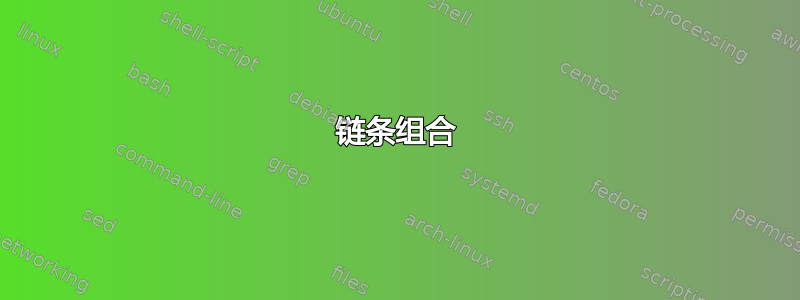
我刚开始使用链库。我想用每条链展示 3 个理解级别
链 1. 初始字段链 2. 解释链 3. 图像
在我的文档的某个时刻,我只想显示chain 1,然后chain 1 & 2,然后chain 1 & 3,最后只显示chain 3。
我需要对齐链,但使用right of不允许我使用if语句。所以我只需要一点帮助,就可以有条件地使用相同的代码来组合链。
这是 MWE
\documentclass{standalone}
\usepackage{tikz}
\usetikzlibrary{chains}
\def\Couleur{orange}
\begin{document}
\begin{tikzpicture}[
start chain=1 going below,
start chain=2 going right,
start chain=3 going below,
node distance=2mm,
Champs/.style={
on chain=1,
rectangle,
rounded corners,
draw=blue!30,
very thick,
text centered,
text width=3cm,
minimum height=12mm,
fill=blue!20
},
desc/.style={
on chain=2,
rectangle,
draw=blue!10,
very thick,
text centered,
text width=6cm,
minimum height=12mm,
fill=blue!5
},
symb/.style={Champs,
on chain=3,
text width=2.3cm,
},
every node/.append style = {
on chain},
]
{[start chain=1]
\node[Champs,] (Level1) {Field 1};
\node[Champs,below=0.1cm of Level1] (Level2) {Field 2};
\node[Champs,below=0.1cm of Level2] (Level3) {Field 3};
\node[Champs,below=0.1cm of Level3,fill=\Couleur!50] (Level4) {Field 4};
\node[Champs,below=0.1cm of Level4] (Level5) {Field 5};
\node[Champs,below=0.1cm of Level5] (Level6) {Field 6};
}
{[start chain=2]
\node[desc,right=of Level1] (Desc1) {Description a bit longer 1};
\node[desc,below=0.1cm of Desc1] (Desc2) {Description a bit longer 2};
\node[desc,below=0.1cm of Desc2] (Desc3) {Description a bit longer 3};
\node[desc,below=0.1cm of Desc3,fill=\Couleur!10] (Desc4) {Description a bit longer 4};
\node[desc,below=0.1cm of Desc4] (Desc5) {Description a bit longer 4};
\node[desc,below=0.1cm of Desc5] (Desc6) {Description a bit longer 6};
}
{
[start chain=3]
\node[symb,right=of Desc1] (Symb1) {\includegraphics[width=1cm]{example-image} };
\node[symb,below=0.1cm of Symb1] (Symb2) {\includegraphics[width=1cm]{example-image}};
\node[symb,below=0.1cm of Symb2] (Symb3) {\includegraphics[width=1cm]{example-image} };
\node[symb,below=0.1cm of Symb3,fill=\Couleur!50] (Symb4) {\includegraphics[width=1cm]{example-image} };
\node[symb,below=0.1cm of Symb4] (Symb5) {\includegraphics[width=1cm]{example-image} };
\node[symb,below=0.1cm of Symb5] (Symb6) {\includegraphics[width=1cm]{example-image} };
}
\end{tikzpicture}
\end{document}
答案1
我认为您没有正确使用链。您不再需要添加所有below=0.1cm of ...if,只要您使用链即可going below。我添加了一些 if。
\documentclass{standalone}
\usepackage{tikz}
\usetikzlibrary{chains}
\def\Couleur{orange}
\newif\ifChainTwo
\newif\ifChainThree
\begin{document}
\begin{tikzpicture}[
start chain=1 going below,
start chain=2 going below,
start chain=3 going below,
node distance=2mm,
Champs/.style={
on chain=1,
rectangle,
rounded corners,
draw=blue!30,
very thick,
text centered,
text width=3cm,
minimum height=12mm,
fill=blue!20
},
desc/.style={
on chain=2,
rectangle,
draw=blue!10,
very thick,
text centered,
text width=6cm,
minimum height=12mm,
fill=blue!5
},
symb/.style={Champs,
on chain=3,
text width=2.3cm,
},
every node/.append style = {
on chain},
]
%\ChainTwotrue
%\ChainThreetrue
{[start chain=1]
\node[Champs,alias=Desc1] (Level1) {Field 1};
\node[Champs] (Level2) {Field 2};
\node[Champs] (Level3) {Field 3};
\node[Champs,fill=\Couleur!50] (Level4) {Field 4};
\node[Champs] (Level5) {Field 5};
\node[Champs] (Level6) {Field 6};
}
\ifChainTwo
{[start chain=2]
\node[desc,right=of Level1] (Desc1) {Description a bit longer 1};
\node[desc] (Desc2) {Description a bit longer 2};
\node[desc] (Desc3) {Description a bit longer 3};
\node[desc,fill=\Couleur!10] (Desc4) {Description a bit longer 4};
\node[desc] (Desc5) {Description a bit longer 4};
\node[desc] (Desc6) {Description a bit longer 6};
}
\fi
\ifChainThree
{
[start chain=3]
\node[symb,right=of Desc1] (Symb1) {\includegraphics[width=1cm]{example-image} };
\node[symb] (Symb2) {\includegraphics[width=1cm]{example-image}};
\node[symb] (Symb3) {\includegraphics[width=1cm]{example-image} };
\node[symb,fill=\Couleur!50] (Symb4) {\includegraphics[width=1cm]{example-image} };
\node[symb] (Symb5) {\includegraphics[width=1cm]{example-image} };
\node[symb] (Symb6) {\includegraphics[width=1cm]{example-image} };
}
\fi
\end{tikzpicture}
\end{document}
如果你取消注释,\ChainTwotrue你会得到
如果你取消注释,\ChainThreetrue你会得到
如果你取消注释两者,你会得到
请注意,还可以使橙色着色更加自动化。
\documentclass{standalone}
\usepackage{tikz}
\usetikzlibrary{chains}
\def\Couleur{orange}
\newif\ifChainTwo
\newif\ifChainThree
\begin{document}
\begin{tikzpicture}[
start chain=1 going below,
start chain=2 going below,
start chain=3 going below,
node distance=2mm,
Champs/.style={
on chain=1,
rectangle,
rounded corners,
draw=blue!30,
very thick,
text centered,
text width=3cm,
minimum height=12mm,
fill=blue!20,
cond={4}{fill=\Couleur!50}
},
desc/.style={
on chain=2,
rectangle,
draw=blue!10,
very thick,
text centered,
text width=6cm,
minimum height=12mm,
fill=blue!5,
cond={4}{fill=\Couleur!10}
},
symb/.style={Champs,
on chain=3,
text width=2.3cm,
cond={4}{fill=\Couleur!50}
},
every node/.append style = {
on chain},
cond/.code 2 args={\ifnum\tikzchaincount=#1
\tikzset{#2}
\fi}
]
\ChainTwotrue
\ChainThreetrue
{[start chain=1,nodes=Champs]
\node[Champs,alias=Desc1] (Level1) {Field 1};
\node[Champs] (Level2) {Field 2};
\node[Champs] (Level3) {Field 3};
\node[Champs] (Level4) {Field 4};
\node[Champs] (Level5) {Field 5};
\node[Champs] (Level6) {Field 6};
}
\ifChainTwo
{[start chain=2]
\node[desc,right=of Level1] (Desc1) {Description a bit longer 1};
\node[desc] (Desc2) {Description a bit longer 2};
\node[desc] (Desc3) {Description a bit longer 3};
\node[desc] (Desc4) {Description a bit longer 4};
\node[desc] (Desc5) {Description a bit longer 4};
\node[desc] (Desc6) {Description a bit longer 6};
}
\fi
\ifChainThree
{
[start chain=3]
\node[symb,right=of Desc1] (Symb1) {\includegraphics[width=1cm]{example-image} };
\node[symb] (Symb2) {\includegraphics[width=1cm]{example-image}};
\node[symb] (Symb3) {\includegraphics[width=1cm]{example-image} };
\node[symb] (Symb4) {\includegraphics[width=1cm]{example-image} };
\node[symb] (Symb5) {\includegraphics[width=1cm]{example-image} };
\node[symb] (Symb6) {\includegraphics[width=1cm]{example-image} };
}
\fi
\end{tikzpicture}
\end{document}







